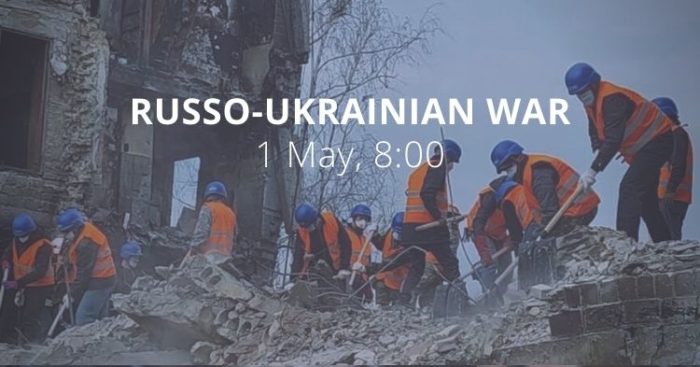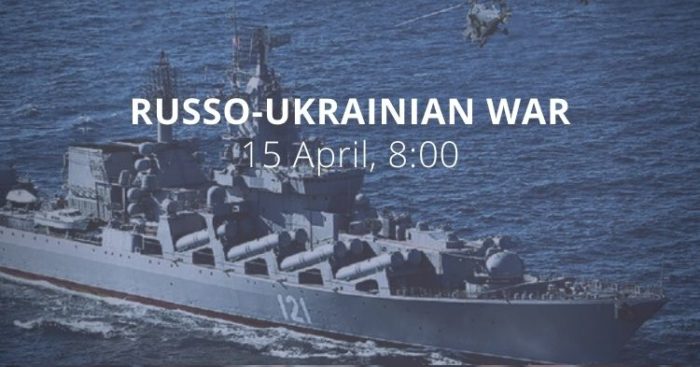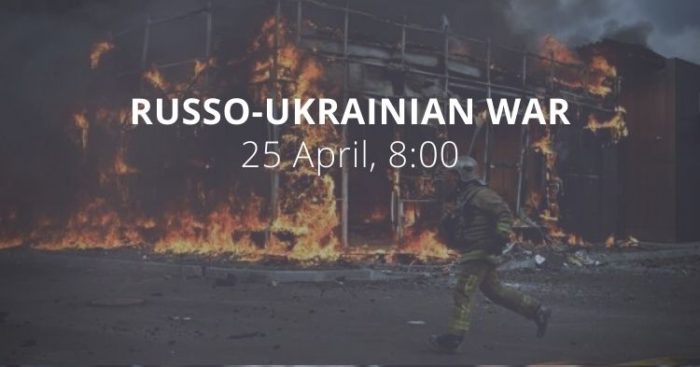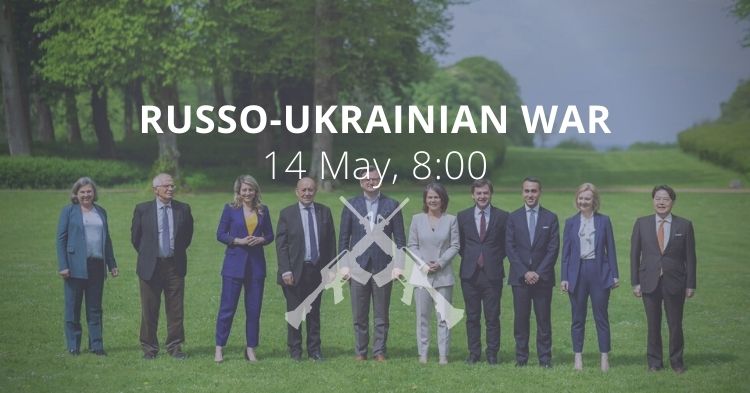Morning report day 82 – May 16
Situation
According to information from the General Staff as of 06.00 16.05.2022, supplemented by its [18:00 assessment].
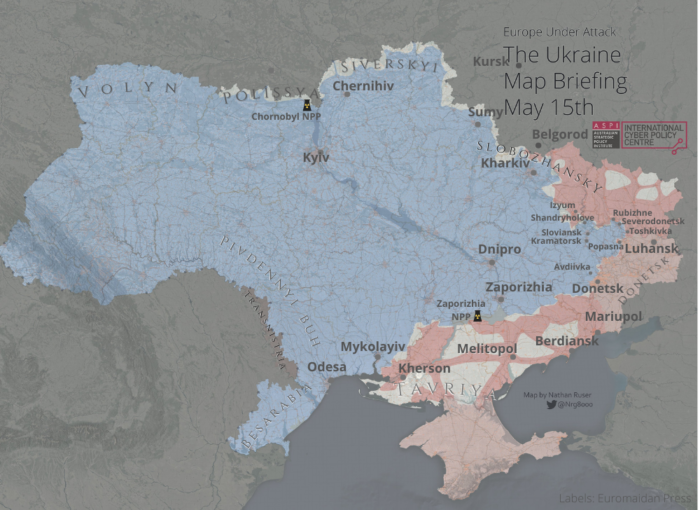
[Russian forces do not stop conducting the offensive to establish full control over the territory of Donetsk, Luhansk, and Kherson oblasts and maintain the land corridor with the temporarily occupied Crimea.]
Russian aviation affected civil and military infrastructure in the eastern operating area and industrial sites in the depths of the territory of Ukraine.
In Volyn and Polissya directions, the enemy did not take active actions. The identified units of the Armed Forces of the Republic of Belarus (up to seven battalions) continue to be tasked with covering the site of the Ukrainian-Belarusian border.
- [No signs of the formation of offensive groups were found.]
- Until May 21, the next stage of battle readiness checks of the response forces of the Armed Forces of the Republic of Belarus will continue. The activity of the mobile radio monitoring complex in the border lane is recorded, including in the territory of Ukraine. It operates to monitor cellular networks.
In the Siverskyi direction, the enemy intensified the control of the Ukrainian-Russian border in the Bryansk and Kursk oblasts and conducts demonstration actions, to maintain the units of defence forces in the direction and prevent their transfer to the eastern operating area. The likelihood of shelling and rocket launchers from the territory of the Russian Federation continues to remain.
- [Russian forces fired missiles at civilian infrastructure in the settlements of Shipylivka and Shevchenkove, Sumy Oblast.]
In the [Slobozhanskyi direction], the enemy concentrates basic efforts on maintaining positions and preventing the promotion of our troops towards the state border of Ukraine with the Russian Federation. [In this direction, Russian forces use units that were formed during the mobilization in the temporarily occupied territories of the Donetsk and Luhansk oblasts.]
https://twitter.com/EuromaidanPress/status/1525968267424239616
- The enemy did not conduct active hostilities in the Sloviansk direction. Carries out additional staffing and replenishment of losses.
- The Russian occupiers fired artillery at civilian infrastructure in the settlements of Dovhenke, Ruski Tyshky, Ternova, and Petrivka. The enemy conducted air reconnaissance with the help of the “Orlan-10” UAV.
- [They are trying unsuccessfully to conduct offensive and assault operations in the areas of Dovhenke and Bohorodychne settlements.]
[In the Donetsk direction, Russian forces continue to carry out intense shelling along the line of contact and try to gain a foothold in the occupied positions, replenishing stocks of ammunition and fuel and oil. The main efforts of Russian forces continued to focus on the Lyman, Sievierodonetsk, Bakhmut, Avdiivka, and Kurakhove areas.]
- In the Lyman, Bakhmut, and Kurakhove directions, the enemy continues to conduct the offensive, and the fighting continues.
- [It conducted assault and offensive operations in the Kurakhove direction, using artillery support. It was not successful.]
- In the Avdiivka direction, after the losses inflicted by the Defense Forces, the enemy retreated to the previously occupied positions. [Russian forces suffered losses in the area of the settlements of Pisky and Novokalynove. It used heavy flamethrower systems in some areas.]
- [In the Sievierodonetsk direction, Russian forces, with the support of artillery, fought in the area of the village of Toshkivka. In the area of Borivskyi, Russian occupiers suffered losses and retreated.]
- [In the Novopavlovsk and Zaporizhzhia directions, Russian forces tried to fire our troops with multiple rocket launchers, artillery and mortars. There were attempts to fight the counter-battery.]
- In Mariupol, the enemy continues massive artillery and airstrikes. The main efforts of the occupiers focused on the blocking and damage of our units in the Azovstal plant.
[In the Pivdennyy Buh direction, enemy units did not conduct active hostilities. In the Kryvyi Rih and Mykolayiv directions, Russian forces fired at our units with artillery and mortars. Continues the engineering equipment of the occupied positions.]
- The defence forces struck at enemy positions near the village of Chornobaivka and lost manpower and equipment.
During the previous day, the Air Defence Forces of the Air Forces and Land Forces of Ukraine units hit eleven air targets: two helicopters (KA-52 and Mi-28), seven UAVs of operative-tactical level and two cruise missiles.
Air Force of Ukraine aviation in certain directions continued to cause fire strikes from the air on Russian forces, support the fighting of Ukrainian troops and patrol the airspace of Ukraine.
In the Donetsk and Luhansk directions, seventeen enemy attacks were repulsed in the last day and three tanks, one artillery system, six units of combat armoured vehicles and one enemy vehicle were destroyed.
[Russian occupiers suffered significant losses in manpower and equipment. In some areas, the staffing of units, according to the results of hostilities, is less than 20 percent.]
[In the Popasna direction, due to heavy losses and inability to act independently, units of the airborne troops of the armed forces of the Russian Federation are teaming up with representatives of Russian private military companies for further action as part of the combined units.]
[The command of the armed forces of the Russian Federation is trying to recruit and replenish the losses of its troops at the expense of reservists. 2,500 reservists are being trained at landfills in Voronezh, Belgorod and Rostov oblasts. It is planned to send them to the territory of Ukraine to take part in the war.]”
10% of the territory of the Luhansk Oblast is controlled by Ukraine, the Ukrainska Pravda reports. Serhii Haidai, the Head of the Luhansk Oblast, said that 10% of the territory of Luhansk Oblast is controlled by Ukraine. The outskirts of Rubizhne, Lysychansk and Sievierodonetsk (+ villages and towns belonging to those communities), as well as the Hirske municipal community and territory along the Lysychansk-Bakhmut road to the border with the Donetsk Oblast, are under Ukrainian control.
https://twitter.com/EuromaidanPress/status/1526043763025403904/
The Ukrainian Armed Forces have allegedly pushed the Russian forces near Kharkiv over the state border, the Ukrainska Pravda reported tonight.
Ukrainian forces destroyed a firing position of Russian MLR systems, the Ukrinform
reports. They destroyed: BM-21 Grad MLR systems – two units; MLRS BM-27 Uragan – one unit; 1L260 Zoopartk-1M counter-battery radar - one unit; more than five units of transport vehicles; as well as an ammunition storage site. This was reported by the forces’ command on Facebook
Intelligence reveals the number of Kadyrov militants fighting in Ukraine, the Ukrainska Pravda reports. "It is significant that despite all the training, morale and equipment that Kadyrov's apparently had, even outside the active combat zone, out of 2,500 mercenaries, about a hundred have been killed, about three hundred have been injured, and more than sixty have fled Ukraine, leaving their weapons and ammunition behind," the Defence Intelligence of Ukraine (DIU) claims. DIU noted that Kadyrov's militants came to Ukraine in the second echelon of the offensive and were involved in house searches, the bullying of hostages and civilians, robberies and looting.
According to British Defence Intelligence, (last 24 hours):
- Following exercise activity earlier this month, Belarus has announced the deployment of special operations forces along the Ukraine border, as well as air defence, artillery and missile units to training ranges in the west of the country. The presence of Belarusian forces near the border will likely fix Ukrainian troops, so they cannot deploy in support of operations in the Donbas.
- Despite early speculation, to date, Belarusian forces have not been directly involved in the conflict. However, Belarusian territory was used as a staging post for Russia’s initial advance on Kyiv and Chernihiv. Russia has also launched air sorties and missile strikes from Belarus.
- Belarusian President Lukashenka is likely balancing support for Russia’s invasion with a desire to avoid direct military participation with the risk of Western sanctions, Ukrainian retaliation and possible dissatisfaction in the Belarusian military.
As of Monday 16 May, the approximate losses of weapons and military equipment of the Russian Armed Forces from the beginning of the war to the present day:
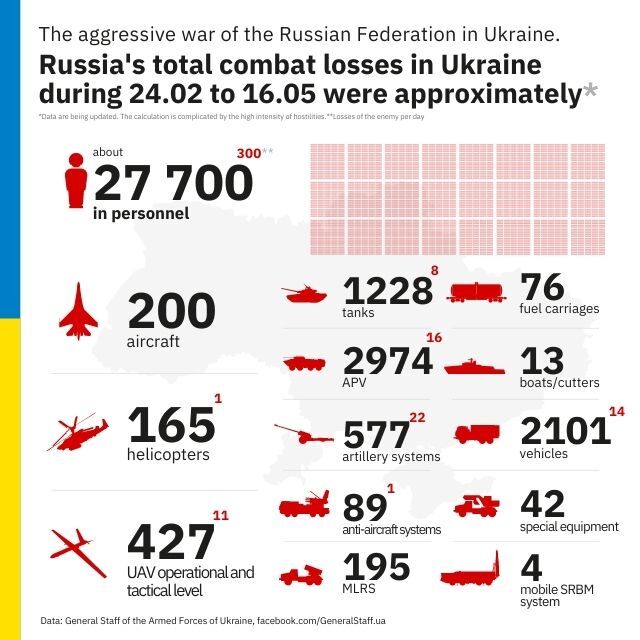
Russian enemy suffered the greatest losses (of the last day) in the Bachmut and Zaporizhzhia directions.
Humanitarian
Denisova calls on the UN, and ICRC to evacuate Azovstal defenders to a third country, the Ukrinform reports. “Verkhovna Rada Commissioner for Human Rights Liudmyla Denisova has called on the United Nations and the International Committee of the Red Cross (ICRC) to rescue Ukrainian servicemen from the city of Mariupol and evacuate them to a third country. The relevant statement was made by Verkhovna Rada Commissioner for Human Rights Liudmyla Denisova on Facebook, an Ukrinform correspondent report.
In her words, the Russian Federation violates the rights of the wounded Ukrainian servicemen to medical care. About 600 wounded Ukrainian servicemen are remaining in extremely difficult conditions within the Mariupol-based Azovstal plant.”
Russian President Vladimir Putin does not agree to the rescue of people from the Azovstal steel mill in Mariupol, the Ukrinform reports. "The state is doing a lot to free our Azovstal defenders, but this is a military operation and these things cannot be disclosed in public. We were able to tell this openly to the relatives because they have the right to know this. And I really hope that most of the issues have been resolved. […] Putin simply does not agree that we could release our Azovstal defenders," Ukraine's Deputy Defense Minister Hanna Maliar said.
According to UNHCR 6,111,172 refugees have been registered as of May 13. The UN says that so far Poland has taken in 3,315,711 refugees, Romania 901,696, Russian Federation 800,104, Hungary 594,664, Republic of Moldova 461,742, Slovakia 415,402 and Belarus 27,308. Among those who fled Ukraine are also Ukrainian nationals with dual citizenship. An additional 105,000 people moved to the Russian Federation from the Donetsk and Luhansk oblasts between 18 and 23 February.
The number of Ukrainians entering Ukraine since February 28 is 1,689,500 as of May 13. This figure reflects cross-border movements, which can be pendular, and does not necessarily indicate sustainable returns.
OHCHR recorded 7,389 civilian casualties in Ukraine as of May 14. 3,573 were killed (including 241 children) and 3,816 injured (including 357 children).
Legal
Russia has launched covert mobilization in the temporarily occupied Ukrainian territories, and even women could be drafted into the Russian armed forces, the Ukrinform reports. Parliamentary Commissioner for Human Rights Liudmyla Denisova wrote on Telegram.
"This is going on in the temporarily occupied Crimea, where many citizens during the conscription campaign will refuse to fight against the Ukrainian army and surrender to the Armed Forces," she said. According to her, all men of draft age (16-60) in the city of Saki and the Saki district have been told to report to a military draft office from May 16 through May 20 for an ID checkup.
 According to the Ukrainian Parliament's Commissioner for Human Rights, forcible mobilization is prohibited by international humanitarian law. Article 51 of the IV Geneva Convention relative to the Protection of Civilian Persons in Time of War prohibits an occupying power from compelling protected persons to serve in its armed or auxiliary forces.”
According to the Ukrainian Parliament's Commissioner for Human Rights, forcible mobilization is prohibited by international humanitarian law. Article 51 of the IV Geneva Convention relative to the Protection of Civilian Persons in Time of War prohibits an occupying power from compelling protected persons to serve in its armed or auxiliary forces.”
229 children were killed, and 421 children injured, the Office of the Prosecutor General of Ukraine reports as of May 16. 1,748 educational establishments are damaged as a result of shelling and bombings, 144 of them are destroyed fully. 11,674 crimes of aggression and war crimes and 5,553 crimes against national security were registered.
Support
The list of anti-Ukraine Republican lawmakers is growing fast, The Washington Post reports. “In early March, the Kentucky Republican was one of just three lawmakers to oppose the first piece of legislation designed to show US support for Ukraine in its war against an invading Russian army, a familiar lonely spot for the libertarian-leaning lawmaker frequently at odds with his party’s leaders.
But on Monday, Massie spoke to Trump for the first time in more than two years — and received the former president’s endorsement in the May 17 Kentucky primary. And on Tuesday, 56 Republicans joined Massie in opposing the latest push to send arms to the Ukrainian forces.
“It’s growing by the week,” he told reporters in an impromptu 20-minute conversation off the House floor Friday. He suggested the price tag so far was “insane” and that sanctions against Moscow only increase inflation. “More and more people are agreeing with that.”
Others focus on the fact that more than 70 percent of House Republicans supported the latest Ukraine aid package.
“Pretty much everybody else understands that this isn’t just about Ukraine. It is about our security and peace and stability in the world. So thus far the Republican Party is still there,” [Rep. Adam Smith (D-Wash.), chairman of the House Armed Services Committee] said.
[Rep. Michael McCaul (R-Texas), ranking member of the House Foreign Affairs Committee ] has actually been pleasantly surprised that the anti-Ukraine faction has not grown larger, something he attributes to the success on the ground of Ukrainian troops and the atrocities committed by Putin’s troops.”
McConnell says Senate will vote Wednesday on $40 billion in new Ukraine aid, The Washington Post reports. “Senate Minority Leader Mitch McConnell (R-Ky.) said Sunday he expects the Senate to advance the approval of nearly $40 billion of additional aid to Ukraine on Monday, with a final vote taking place Wednesday, after Sen. Rand Paul (R-Ky.) single-handedly stalled the aid package last week.”
A recent report by the Royal United Services Institute (RUSI) has suggested that the Russian arms industry uses more western-origin components in its weapons systems than previously thought. The report notes that: “Russia’s latest weapons are heavily dependent upon critical specialist components manufactured abroad.” It found that Ukraine’s scientific establishments noted “a consistent pattern” across major Russian weapons systems recovered from the battlefields.
- Pentagon: Russia has problems with resupplying high-precision weapons, the MIL.IN.UA reports. The Russian army has problems with resupplying high-precision weapons. “This was announced by an American official of the US Department of Defence at a briefing. Sanctions against Russia are beginning to damage its defence industry operations, including the production of new weapons. According to a senior US Department of Defence official, it is challenging for the Russian military to resupply its stocks of high-precision guided munitions. We do believe that the sanctions and the export controls, particularly when it comes to components, electronic components have had an effect on the Russian defence industrial base and their ability to restock PGMs., the US official said.”
- A Russian facility responsible for the production of surface-to-air missiles (SAMs) has been shut down due to import restrictions and Western sanctions, The Jerusalem Post reports. This is because, as noted by employees, "almost nothing Russian" is used during the critical state of production when electronic components are used.
Most of the Russian military's electronic components were provided by Germany, but with sanctions in place, Germany is no longer providing Russia with any supplies.
With the factories closed, however, the workers are given one of two choices: Go on unpaid leave or join the Russian army to serve in the war with Ukraine, preferably as a SAM operator, and get a monthly salary of 50,000 rubles (around $600).
Earlier in April, a Vladivostok shipyard was allegedly unable to meet 25 billion rubles' worth of government orders to build two tankers, and two
missile boats, and to maintain and repair other vessels.
It is obvious that the Russian military-industrial complex remains dependent on imported high technologies, Ukraine's GUR said. Without the supply of which Russia is unable to continue production of modern weapons."
- The main manufacturer of Russian tanks, Uralvagonzavod, halted production back in March also due to a lack of components and parts, the SOFREP reports. The company had its assets frozen by the British Government last February 24th, with the US government having it sanctioned since 2014 due to the Russian annexation of Crimea. With a large number of Russian tank losses in Ukraine, and with many more to come as the Ukrainians have been armed with Western anti-tank and anti-armour weapon systems such as the Javelin, NLAWs, Panzerfaust-3s, and their very own Stug-buggies, the Russian forces are not able to replace or repair their tanks – which does ultimately leave them in a vulnerable position.
New developments
- NATO says Ukraine can win the war started by Russia, the Ukrinform reports. "Today we will be focusing on the latest developments in Ukraine. The brutal invasion of Russia is losing momentum. And with significant support from Allies and partners in billions of dollars, in military support, in financial support, humanitarian support, we know that with the bravery of the Ukrainian people and army and with our help Ukraine can win this war," NATO Deputy Secretary-General Mircea Geoană said ahead of the informal meeting of NATO ministers of foreign affairs in Berlin on Sunday, May 15.
- NATO Foreign Ministers discuss Sweden, Finland membership application, reaffirm Ukraine support, NATO reports. “Sweden and Finland are NATO’s closest partners and if they decide to apply for membership, it would be “historic”. Their membership in NATO would increase our shared security, demonstrate that NATO’s door is open and that aggression does not pay,” Mr Stoltenberg said, reiterating that all sovereign nations have the right to choose their own path. Allies also discussed support for Ukraine, further strengthening NATO’s deterrence and defence as well as the longer-term implications of Russia’s war against Ukraine. Ministers also discussed the upcoming NATO Madrid Summit, which is expected to take decisions on reinforcing the Alliance’s posture, strengthening support for global partners, and adopting the Alliance’s next Strategic Concept.
- Russia's behaviour amounts to a repudiation of agreement with NATO, Germany says, the Reuters reports. “The Russian government has made it clear that the NATO-Russia Founding Act is no longer worth anything to it. So we now have to acknowledge that this basic act was also unilaterally terminated by Russia, not by NATO," Germany's Foreign Minister Annalena Baerbock told reporters at the end of a NATO foreign ministers meeting. [ME: NATO Secretary-General, Jens Stoltenberg, stated that Russia had walked away from the NATO-Russia Founding Act on 23 March. Already on 25 February, however, he stated that the NATO-Russia Founding Act doesn't work, because one side, Russia, has violated it over many years.]
- Türkiye lays out demands as Finland, and Sweden seek NATO membership, the Reuters reports. “Türkiye's foreign minister said on Sunday that Sweden and Finland must stop supporting terrorist groups in their countries, provide clear security guarantees and lift export bans on Türkiye as they seek membership in NATO”.
- Russia suspends electricity exports to Finland in apparent retaliation for Helsinki’s NATO decision, The New York Times reports. “Russia suspended its electricity supply to Finland on Saturday in apparent retaliation for Helsinki’s decision to upend its longstanding stance of military neutrality by pursuing NATO membership. The suspension could be the first of what Moscow warned on Thursday would be “retaliatory steps” after Finland’s move toward joining the alliance — including an unspecified “military-technical” response, which many experts interpreted as a threat to deploy tactical nuclear weapons near the Russian-Finnish border.”
- Germany to ban Russian oil regardless of EU, Aljazeera reports citing Bloomberg. Germany plans to stop importing Russian oil by the end of the year, even if the EU fails to agree on a ban in its next set of sanctions, Bloomberg has reported citing government officials. “Efforts to seal deals with alternative suppliers are progressing in the chancellery in Berlin and the government is confident it can solve remaining logistical problems within the next six to seven months, according to the officials, who spoke on condition of anonymity,” Bloomberg said.
Assessment On the War
The Institute for the Study of War has made the following assessment as of Sunday 15 May:
 Russian forces have likely run out of combat-ready reservists, forcing the Russian military command to amalgamate soldiers from many different elements, including private military companies and proxy militias, into ostensibly regular army units and naval infantry. The Ukrainian General Staff reported that approximately 2,500 Russian reservists are training in Belgorod, Voronezh, and Rostov oblasts to reinforce Russian offensive operations in Ukraine. That number of reservists is unlikely to generate enough force to replenish Russian units that have reportedly lost up to 20 percent of staffing in some areas—to say nothing of the battalion tactical group that was largely destroyed recently while attempting to cross the Siverskyi Donets River. The Ukrainian Military Intelligence Directorate stated that Russian forces are conducting covert mobilization and creating new units with newly mobilized personnel who likely have insufficient training to be effective and little motivation to fight. Russian forces also deployed new conscripts from occupied settlements in Donetsk and Luhansk oblasts to maintain an offensive around Kharkiv City, likely due to the lack of Russian reserves.
Russian forces have likely run out of combat-ready reservists, forcing the Russian military command to amalgamate soldiers from many different elements, including private military companies and proxy militias, into ostensibly regular army units and naval infantry. The Ukrainian General Staff reported that approximately 2,500 Russian reservists are training in Belgorod, Voronezh, and Rostov oblasts to reinforce Russian offensive operations in Ukraine. That number of reservists is unlikely to generate enough force to replenish Russian units that have reportedly lost up to 20 percent of staffing in some areas—to say nothing of the battalion tactical group that was largely destroyed recently while attempting to cross the Siverskyi Donets River. The Ukrainian Military Intelligence Directorate stated that Russian forces are conducting covert mobilization and creating new units with newly mobilized personnel who likely have insufficient training to be effective and little motivation to fight. Russian forces also deployed new conscripts from occupied settlements in Donetsk and Luhansk oblasts to maintain an offensive around Kharkiv City, likely due to the lack of Russian reserves.
Russian private military companies are reportedly forming combined units with airborne elements due to significant losses in manpower. Denaturing elite airborne units with mercenaries is shocking, and would be the clearest indication yet that Russia has exhausted its available combat-ready manpower reserves. The Russian 810th Guards Naval Infantry Brigade is reportedly receiving personnel from other Black Sea Fleet units, including navy ship crew members. Newly formed or regrouped units are unlikely to be effective in combat.
Russian forces are likely fortifying occupied settlements in southern Ukraine, indicating that the Russians are seeking to establish permanent control in the region. Ukrainian officials reported that Russian forces began digging trenches and building concrete revetments in unspecified areas of Mykolaiv and Kherson Oblast, near Melitopol, and in western Zaporizhzhia Oblast.
Ukrainian village Oleksandrivka on the Black Sea coast in Kherson Oblast was severely destroyed, a drone shows.
Fierce fighting was going on in and around the village since March while nothing was reported about it in the last weeks.pic.twitter.com/MULL2ymnWN
— Euromaidan Press (@EuromaidanPress) May 16, 2022
Key Takeaways
- Russian forces will likely prioritize winning the Battle of Sievierodonetsk over reaching the administrative borders of Donetsk Oblast.
- Russian forces did not advance in the Sloviansk direction due to unsuccessful offensive operations in the Izium area. Ukrainian aviation continues to operate north and east of Izium.
- Russian forces continued to launch artillery, air, and naval assaults on the Azovstal Steel Plant, but Mariupol defenders maintained their positions.
- Russian forces are fortifying occupied settlements along the southern axis, indicative of Russian objectives for permanent control of the area.“
https://twitter.com/EuromaidanPress/status/1526005762765467649
Growing evidence of a military disaster on the Donets pierces a pro-Russian bubble, The New York Times reports. “The destruction wreaked on a Russian battalion as it tried to cross a river in northeastern Ukraine last week is emerging as among the deadliest engagements of the war, with estimates based on publicly available evidence now suggesting that well over 400 Russian soldiers were killed or wounded. And as the scale of what happened comes into sharper focus, the disaster appears to be breaking through the Kremlin’s tightly controlled information bubble.
As the news of the losses at the river crossing in Bilohorivka started to spread, some Russian bloggers did not appear to hold back in their criticism of what they said was incompetent leadership.
Russian attempted to cross river near Bilohorivka, but failed, losing at least a BTG of personnel and equipment, and several pontoon bridges.
Ukrainian military stated that it has foiled nine Russian river crossing attempts. https://t.co/VwgbLb8hp4
— Euromaidan Press (@EuromaidanPress) May 15, 2022
“I’ve been keeping quiet for a long time,” Yuri Podoliak, a war blogger with 2.1 million followers on Telegram, said in a video posted on Friday, saying that he had avoided criticizing the Russian military until now. “The last straw that overwhelmed my patience was the events around Bilohorivka, where due to stupidity — I emphasize, because of the stupidity of the Russian command — at least one battalion tactical group was burned, possibly two.”
Mr. Podoliak ridiculed the Kremlin line that the war is going “according to plan.” He told his viewers in a five-minute video that, in fact, the Russian Army was short of functional unmanned drones, night-vision equipment and other kit “that is catastrophically lacking on the front.” “Yes, I understand that it’s impossible for there to be no problems in war,” he said. “But when the same problems go on for three months, and nothing seems to be changing, then I personally and in fact millions of citizens of the Russian Federation start to have questions for these leaders of the military operation.”
Another popular blogger, who goes by Starshe Eddy on Telegram, wrote that the fact that commanders left so much of their force exposed amounted to “not idiocy, but direct sabotage.”
And a third, Vladlen Tatarski, posted that Russia’s eastern offensive was moving slowly not just because of a lack of surveillance drones but also “these generals” and their tactics.n“Until we get the last name of the military genius who laid down a B.T.G. by the river and he doesn’t answer for it publicly, we won’t have had any military reforms,” Mr. Tatarski wrote.
Western military analysts have also pored over the imagery and say the attempted crossing demonstrated a stunning lack of tactical sense. They have speculated that Russian commanders, desperate to make progress, rushed the operation. Some also suggested that it was a reflection of disorder in the Russian ranks.”
Consequences and what to do?
Why US military aid is working in Ukraine. The amount pales in comparison to what America spent in Iraq and Afghanistan. But the results have been spectacular, NBC News reports.
In contrast to US support to Vietnam, Iraq and Afghanistan, Ukraine has been an immense success story. Why is that?
Well, to begin with, Ukrainian society as a whole was willing to fight in defense of its country. The government wasn’t reliant on the US military to prop it up and to cajole reluctant recruits to defend it. And despite political divisions, over time, the Ukrainian people grew to favor closer relations with Western Europe and the United States. In contrast, arms, money and the blood of thousands of US troops couldn’t infuse Western-oriented governments in South Vietnam and Afghanistan with popular support.
Ukraine’s spirit of national resistance has also meant that most of the US arms transferred to local forces have been used for their intended purpose. In contrast, corruption and disloyalty (and ineptness) saw huge quantities of US military aid to Afghanistan, Iraq and South Vietnam go missing and even end up with enemy forces.
In Ukraine, the US and NATO are helping the country build on its existing strengths instead of reinventing the military top to bottom — as the US had to do in Iraq when it foolishly disbanded the entire military after routing Iraqi leader Saddam Hussein. In Ukraine, beginning in 2014 when the war in eastern part of the country broke out, Washington instead enabled Kyiv to make better use of its huge inventory of Soviet artillery and armored vehicles through modernized training and tactics.
It also focused on delivering mostly nonlethal systems that allowed Ukrainian troops to use the firepower they already had more effectively, such as counter-battery radars that have helped Ukrainian forces detect artillery attacks, night-vision goggles that allow Ukrainian units to
operate at times Russian units can’t and secure communication systems that protect their troop locations.
When it became evident Ukraine was at high risk of being fully invaded by Russia earlier this year, US and British defence officials correctly shifted to providing the kinds of lethal weapons that could be quickly delivered in large quantities and fielded rapidly for maximum impact. In particular, thousands of advanced portable Javelin and Stinger missiles that have light logistical and training requirements and have been ideal for ambushing Russian armoured columns or shooting down low-flying helicopters and planes.
This is a smart change from giving Abrams tanks to Iraq and Blackhawk helicopters to Afghanistan that indigenous personnel struggled to maintain without copious support from American contractors.
It’s also been crucial that the White House helped Ukrainians bog down the more powerful Russian military without deploying American combat troops or aircraft into the battle zone. That has no doubt helped US domestic support for Ukraine remain high — while giving Kyiv more agency to manage the war as it sees fit and reducing the risk of Ukrainian forces becoming dependent on direct US support.
Part of what allowed the US to avoid putting troops in harm’s way is that it has shifted to training Ukrainian soldiers in European countries ever since Putin began intensified hostilities.
Some critics argue that President Joe Biden should have armed Ukraine more heavily before or at the start of the war with jet fighters or Patriot missiles. But Biden had to consider the possibility that Ukraine might collapse in a few days before a Russian onslaught, as some intelligence analysts predicted, allowing weapons to fall into Russian hands before the Ukrainians could even use them.
Furthermore, Biden had to avoid arming Ukraine in ways that Moscow could have seized on to justify launching an invasion. Putin ended up having to attack without that rationale, putting him in a weaker position.
The Biden administration, however, was nimble enough to change course as circumstances allowed. When it became evident Ukraine wouldn’t succumb to a knockout blow, Biden and other NATO allies transferred heavier and more advanced weapons.
When it did so, Washington wisely arranged for Ukraine to receive the Soviet-style weapons its military knew how to operate and maintain rather than reflexively favoring US-made equipment. Though the US didn’t have lots of Soviet weaponry on hand, it had NATO allies like Poland, Slovakia and the Czech Republic that did. So the Biden administration convinced those countries to shuffle older Soviet tanks, artillery, aircraft parts and munitions to Ukraine while promising to backfill their inventory with more modern US systems. That enhanced the military capability of NATO allies while freeing up weapons Ukraine could use immediately in its fight for survival.
That said, Washington has furnished some simpler American-built systems Ukraine could adopt comparatively easily, such as armored Humvees, howitzers and Switchblade kamikaze drones. In remarkably short time, the Pentagon also developed and delivered a customized attack drone specifically for Ukraine to use against armored targets, and mysterious “coastal defence” drone vessels that the US Navy hasn’t officially begun to use.
In the coming months and years, US aid will likely shift toward more advanced capabilities that will take longer to integrate, perhaps including fighter jets, long-endurance combat drones and anti-ship missiles. But that’s only possible now because resolute and tactically proficient Ukrainian troops, aided by the Javelins, halted Russia at the war’s start.
But it has also inaccuracies and perceptions common to many in the West. I, therefore, feel the need to correct some of the most obvious mistakes.
Asking why US support for Ukraine in contrast to Vietnam, Iraq and Afghanistan has been an immense success, is a very pointed question. One of the obvious answers to it, however, should have included the fact that Ukraine is a part of Europe and share close historical links with many countries on the European continent, including Austria, France, Hungary, Lithuania, Norway, Poland, Romania, Sweden, Türkiye, and more.
Having experienced three revolutions since 1990, its Western trajectory has been fixed since 2014 and the Revolution of Dignity. Its aspiration for NATO and the EU has been entered into the Ukrainian constitution. From my own experience, I would even argue that most Ukrainians are more democratic aware than most people in the West because they have been committed to fixing a flawed democracy, striving to achieve something most of us take for granted.
The author argues that the US could not have armed Ukraine more heavily with jet fighters or Patriot missiles before or at the start of the war because President “Biden had to consider the possibility that Ukraine might collapse in a few days before a Russian onslaught, as some intelligence analysts predicted, allowing weapons to fall into Russian hands before the Ukrainians could even use them.”
That argument is only valid if the war started on 24 February, and the US Intelligence only became aware of the military build-up along the Ukrainian borders last fall. Both assumptions are, however, false. Both the War and the military build-up started more than 8 years ago.
The West has collectively refrained from helping Ukraine rebuild its Armed Forces and establish a deterrent since 2014, which might have stopped a low-intensity Hybrid War from turning into a full-scale war. The lack of lethal aid and a “Marshall-plan” to help rebuild the Ukrainian Navy and Air Force in the face of Russian modernisation, militarization, and build-up process, only helped the Russian Federation.
Additionally, the lack of Western defence support to Ukraine might also have been misinterpreted as both lack of commitment and weakness by President Putin, triggering a full-scale war on what he mistakenly believed to be a “window of opportunity”. made
The article also argues that it was smart not to provide Ukraine with more advanced systems like Abrams tanks or Blackhawk helicopters because, based on the Iraq and Afghanistan experience, “indigenous personnel” struggle to maintain these “without copious support from American contractors.” If we ignore the fact that “lifetime support” is commercially beneficial to the producer and, therefore, often an integrated part of any procurement contract, the article ignores how technical advanced Ukraine is compared to many of its neighbour countries.
Additionally, Ukraine has a huge defence industry. Ukroboronprom State Concern is a strategic manufacturer of weapons and military hardware in Ukraine. The Concern alone employs about 67,000 highly skilled workers. In 2019 Ukraine occupied the 12th spot among global arms exporters according to Stockholm International Peace Research Institute (SIPRI).
The biggest flaw in the article, however, is the notion that the decision to not deploy aircraft into the battle zone has given “Kyiv more agency to manage the war as it sees fit and reducing the risk of Ukrainian forces becoming dependent on direct US support.”
- Firstly, all of Europe is crucially dependent on US defence support. NATO would not be a collective defence alliance without the USA as one of its founding members. Why should Ukraine be better prepared to stand alone in the face of open aggression?
- Secondly, the idea that Ukraine can defeat Russia, evict Russian forces from the occupied territories and break the maritime embargo without a robust Air Force and a Navy (which Ukraine does not have), is simply not true. That is exactly why Ukraine has been calling on the international community to establish a No-Fly Zone in its airspace and help open the maritime transport routes in the Sea of Azov and the Black Sea.


